Posted by SolidShops on August 28, 2012 at 02:25 AM
We’ve just upgraded all stores to the latest version of the SolidShops e-commerce CMS. This is a maintenance release with a few improvements, based on the feedback we’ve received from you all.
Here’s a short summary of items that have been fixed or improved in this release:
- Fixed the error that occured when saving a product when a custom field (with combobox) was not filled in.
- Order export didn’t show abandonned orders and therefore a gap in the number range occured.
- The column date_paid has been added to the CSV order export.
- Shipping & tax is now set to 0 when you haven’t selected a country to ship to yet. Before, the values for “The rest of the world” were used.
- Categories and custom fields have been added to the product export feature. So from now on, you can export your products and import them into another store (with the exception of product variants).
- The Google Checkout payment page contains more information about a SolidShops order.
- In some occasions, a SolidShops order was not set to “paid” in the CMS, while this would the case in the Google Checkout backend
- It wasn’t possible to use the same Google Checkout account within multiple SolidShops accounts, this limitation has been removed.
Thanks for sending in your feedback, we’ll keep improving the software and are planning a few larger updates for our next release.
Keep on selling!
Posted by SolidShops on August 02, 2012 at 12:08 PM
We’ve just upgraded all stores to the latest version of the SolidShops e-commerce CMS. This is a maintenance release with a few improvements, based on the feedback we’ve received from you all.
Here’s a short summary of items that have been fixed or improved with this release:
- taxes and shipping support for Channel Islands and Canary Islands has been added
- from now on it’s possible to export all your product data into a CSV or XML file
- the last lines of a template were not shown in fullscreen editing mode, this has been fixed
- in some cases, the template editor opened in fullscreen mode by default, this has been resolved
- a warning message is now shown if you want to edit a product price when variant prices are already used
- from now on, you can have up to 10 custom cart attributes instead of 5
- mailing list preference from your customers is now shown on every order details screen
- some users experienced a sudden logout of the system, this has been fixed
- custom email address and mailing list preference have been added to order export data (and API in beta)
Thanks for sending in your feedback, we’ll keep improving the software and are planning a few larger updates for our next release.
Keep on selling!
Posted by SolidShops on July 11, 2012 at 09:32 PM
We’ve just upgraded all stores to the latest version of the SolidShops e-commerce CMS. This is a maintenance release with a few improvements, based on the feedback we’ve received.
- the code editor now supports control+S (Windows) or cmd+S (Mac) to save
- fixed a bug where you had to paste twice in order for the editor to pick up the code from your clipboard
- you can now press “escape” to exit fullscreen mode in your code editor
- implemented a better “full screen” editor mode, which works better on any screen resolution
- fixed a bug where some people would get an email when a customer cancelled an iDeal payment
- fixed a bug where adding comments to an order would cause the loading indicator to stay on screen
- improved our product import script with custom fields and documentation
Thanks for sending in your feedback, we’ll keep improving the software and are planning a few larger updates for our next release.
Keep on selling!
Posted by SolidShops on July 04, 2012 at 02:04 PM
I absolutely love what Stijn did for his new born baby Jack! He used SolidShops to set up a personal birth list for baby Jack instead of going the traditional route. Baby stores tend to have birth list software themselves but we’ve all ended up being frustrated with how those tools tend to work right?
On top of that, how cool is it to have a custom branded store for your baby! Congratulations Stijn and Anneke, not only on the store but especially with baby Jack!
http://www.babyjack.be

Posted by SolidShops on June 04, 2012 at 02:12 PM
I know what you’re probably thinking: “scheduling facebook updates isn’t authentic”. But think about this: here at SolidShops we have composed a large list of e-commerce tips for small businesses over the past months or even years. We’d like to share all those tips with our readers, but you know how much hassle it can be to plan for sharing Facebook or even Twitter updates on a daily basis.
In such case it would be very convenient if we could simply schedule one e-commerce tip every day to be published at predictable time intervals. That way our readers would know that they would receive an e-commerce tip every day during lunch time for example, while we can focus on delivering great support and building new features.
The good news is: now you can schedule updates on Facebook without the need for an external app!
To do so, go to your Facebook page as usual and type an update. You will notice a small clock icon in the left bottom corner just like in the screenshot below:
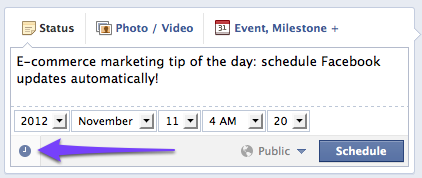
Click on that icon to reveal scheduling options for your status update. You can select a date and time slot up to six months in the future.
What’s also cool is that you can select additional options for publishing your update to for example only people in a certain demographic or country.
Managing your scheduled posts can be done from your activity log. At the top of your Facebook page, click on “Manage” and “Use Activity Log”. There you will find all your scheduled posts which you can edit or cancel at any time.

For those of you using an external app like Tweetdeck or Hootsuite to schedule posts, keep in mind that Facebook will probably give a higher value or so called Edgerank to posts that were scheduled directly in Facebook versus posts that are coming from an external app.
Tell me, will you be using scheduled updates and if yes, what kind of posts do you think can be scheduled without breaking the authentic connection you have with your followers?
Posted by SolidShops on May 20, 2012 at 06:14 PM
SolidShops v1.4.4 improves the way you can handle taxes on your orders and enables linking multiple domain names to your store. Read on for a number of practical use cases.
Taxes: private individuals vs. companies
We’ve received feedback from a number of store owners that wanted a way to charge different taxes depending on wether a customer is a private individual versus a company. Here’s how you can accomplish just that.

When you navigate to your “settings : taxes” page you will see that there are now two separate columns where you can enter different tax percentages for either private individuals and companies.
We will differentiate between those two customer types by checking if a customer has entered a company/VAT ID on the checkout page or not.
Simply put: if a customer enters a VAT/Company ID on the checkout page, we will charge the tax percentage in the column that says “Taxes Companies”. If a customer leaves the VAT/Company ID field empty, we will charge the tax percentage from the column that says “Taxes Individuals”.

Linking multiple domain names to your store
When you link a custom domain name to your SolidShops store, you need to set the CNAME’s of your DNS records. That’s easy enough to do, but some DNS registrars don’t allow you to redirect e.g. www.yourstore.com to http://yourstore.com and the other way around.
To solve this problem for a number of customers, we’ve added the ability to link up multiple domain names to your store. This way you can set both the CNAME “yourstore.com” and “www.yourstore.com” to point to your SolidShops account. Just set those two domains in your settings and we’ll do the rest.
Another use case is moving from one domain to another. Add your new and primary domain name as the first domain and then add your old domain name as your secondary domain. That way, visits to both domain names will continue to work, but we’ll permanently redirect all requests from your old domain name to the new one. Search engines will pick up that redirect and will update your domain name in the search results.

That’s it for this release folks. Let us know what you need in order to build better stores for your clients and we’ll make sure to update SolidShops accordingly. Thanks again for all the feedback, it’s making SolidShops better, one release at a time.
Posted by SolidShops on April 30, 2012 at 02:49 PM
By using custom fields, there’s nothing you can’t do with your products in SolidShops. In the short tutorial I’ll walk you through how you can add in your own fields to be used for SEO purposes.
SolidShops does a great job for SEO out of the box by e.g. reading in your product description automatically, but if you want greater control over this process, you can do so easily by adding some custom fields to your products.
Let’s get started by creating a new field group called “SEO”. You can pick any name, just don’t use spaces in the group name.
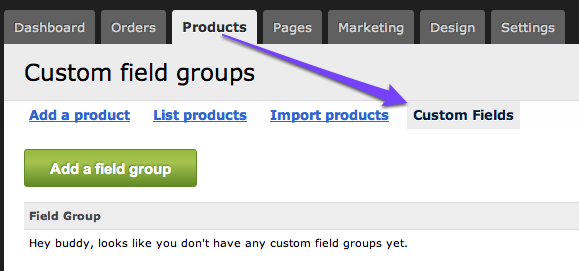
Click the “Add a field group” button to create your first field group and give it the name “SEO Fields”.
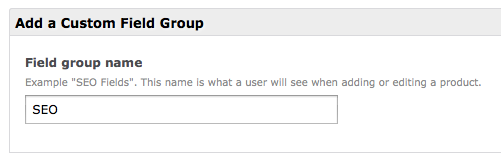
Once we have this group, we can start adding fields, by clicking on the “Add/Edit fields” link next to the field group you just created.


To keep things simple, we will add one field that we can use to enter a specific product description to be used in our SEO meta tags. Name the field “seo_description” and give it the label “SEO Description”.
The “Field Name” is a unique technical name or ID if you will that we will use later in our templates to read out the value a user has typed into this field. The “Field Label” is what a user will see when editing product information.
Make sure to set the Field Type to “Text Area”. We want to be able to enter multiple lines of text for our product description meta tag.
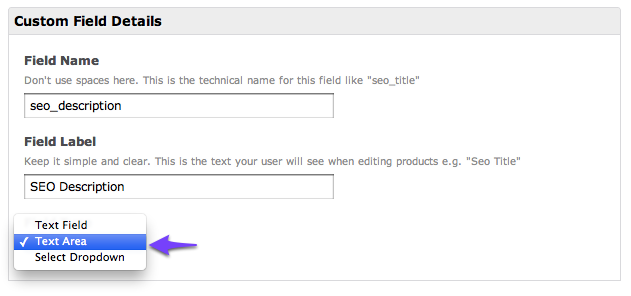
We’re done configuring our custom fields. Now let’s add or edit a product. When you do, you will notice we now have the option to select a Custom Fields group.
Pick the group named “SEO Fields” you created earlier and you will see that the custom fields associated with that field group get loaded up in your products screen.
Now just add in the SEO Description you want and save your product like you would normally.
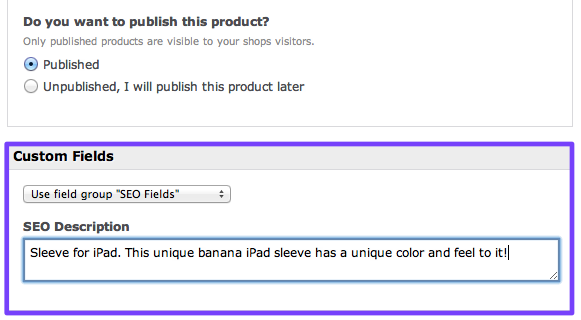
Now open your template named “product” and we’ll add in this data in the <head> section of your document. We want to use the custom SEO Description field you just added.
What the code sample below does, is check if there are any custom fields linked to this product. If there are, we will loop over all of them, printing our the seo_description field when we see it.
{% if product.custom_fields.SEO|length > 0 %}
{% for field_group,arr_field_group in product.custom_fields %}
{% for field_name, arr_field in arr_field_group %}
{% if field_name == "seo_description" %}
<meta name="description" content="{{ field_name.value }}" />
{% endif %}
{% endfor %}
{% endfor %}
{% endif %}
In your store, this will now generate the following meta tag, completely under your own control:
<meta name="description"
content="Sleeve for iPad. This unique banan iPad sleeve has
a unique color and feel to it!" />
If you prefer to just quickly load one of your custom fields, you can do so as well:
{{product.custom_fields.SEO.seo_description.value }}
This example focuses on creating extra fields for SEO purposes, but of course, any other scenario is possible. Use custom fields to allow your clients to enter any type of data for the products they are creating.
Let us know in the comments what you are using custom fields for, we’d love to know!
Posted by SolidShops on April 30, 2012 at 02:49 PM
SolidShops keeps improving, thanks to the feedback of our committed users. Thanks you for that!
We’ve incorporated the most requested new feature in this version: custom product fields. With custom product fields, the possibilities of managing products in your store have practically become limitless.

Here are some real life use cases for custom fields, that our users have submitted to us:
Example 1: Adding a marketing quote and Author field to books
One of our users is using custom fields to add fields to the books he’s selling. He wanted the possibility to add author to the book.
On top of that, he wanted the possibility to add a marketing quote to each book, to promote its sales.
Here is our documentation on how to implement custom fields.
Example: Adding extra fields for more SEO control
The SolidShops application is doing a great job for optimizing your stores for optimal rankings in search engines, out of the box. But if you want more control to e.g. enter your own product description to be used for SEO, you can.
We’ve written a short tutorial here on how to implement custom fields for extra SEO control.
Other fixes and improvements
- added discount coupon information to order confirmation emails
- added discount coupon information to default invoice template
- added discount coupon information to mobile order view
- support for Norwegian and other non-standard character sets in email templates
- support for Norwegian and other non-standard character sets in PDF invoice templates
- we now load less orders by default in the mobile app for better performance
- added feedback when removing a payment method from your settings
- added documentation for in-store pickups or “pay on delivery”
- added support for Norwegian Krone (NOK) currency
- added the ability to send invoice PDF links to your clients
- clicking on a product image now open the edit mode for that product
- fixed a bug where coupon dates would not be set to the right day
- new template filter: explode
- new template filter: trim
We hope you like this update. Especially the possibility to hook in your own custom fields into products has been requested a lot over the past few months.
We’re now focusing on the next release, which will include a fix for setting VAT/Sales tax based on whether a client is a company or an individual. Stay tuned for more information and thanks for your ongoing support!
Posted by SolidShops on April 25, 2012 at 10:06 AM
When you are using the SolidShops PDF invoices feature to automate the generation of your invoices in any style you want, you can run into a problem when your clients have non standard characters in their names.
Using characters such as æ ø å og Æ Ø Å can generate some weird looking stuff in your final invoices. Luckily, there is an easy way to solve this. Open up your PDF invoice template and make sure you add the following meta tag in the head of your template.
<meta http-equiv="Content-Type" content="text/html;charset=utf-8" />
When generating the final invoice, we will detect the meta tag and use UTF-8 encoding in your invoice. This is tech-speak for “we will make sure that any non default characters get shown properly in your invoices”.
Thanks to our user Jon to make us aware of this problem.
Posted by SolidShops on March 14, 2012 at 11:48 AM
Finding the best ecommerce solution for building an online store isn’t always easy. You can choose between going the open source route or you can go for a fully hosted SaaS application. Both approaches have their advantages and disadvantages. In this post I’ll try to clarify the differences between both to help you decide which approach is best for your business.
Before you continue reading, you should know that we ourselves are a commercial and hosted solution. In this article I’m simply trying to demonstrate and clarify what the difference is between open source software and commercial hosted ecommerce solutions.
There is no clear winner here, it all depends on what you exact needs are. Let’s get started, shall we?
An open source solution isn’t free
Let’s get a misconception out of the way first. A big advantage is that you can download and implement open source ecommerce solutions free of charge. That means you don’t have to pay a license to download or use the software.
What that also means is that you are responsible for installing, maintaining, securing and configuring the software on your own servers. Unless you are a technical person yourself with lots of free time, setting up an open source solution will take up time.
For most people, time is a valuable thing and you will need to charge your client for the time you spend setting up an open source solution. That cost adds up.
If you are not a technical person yourself, you will need to hire a web designer or developer that can take care of this process for you. By the time you’ve got a working setup, open source isn’t as free anymore as you might thought is was.

Illustration by: http://www.flickr.com/photos/hikingartist
But how can a hosted solution be more cost effective than free?
As you know by now, open source isn’t free unless you’re doing all the work of setting up an open source solution yourself and your time isn’t worth a penny. Even then, you still have to pay for hosting, SSL security and again spend time on maintaining the software whenever an upgrade comes out.
A simple comparison
Let’s take a look at the basic tasks that one has to tackle when using an open source solution.
- installing and setting up the open source solution: 1-2 hours
- buying and installing an SSL certificate for one year: 1 hour (costs between 30$ and 150$ yearly)
- hosting your ecommerce store: 150$ yearly (cheap estimate)
- renewing the SSL certificate every year (1 hour)
- updating/patching the open source software every few months (4 hours)
Of course, rates depend on where you are but it’s fair for a web developer to charge you 50$ an hour over here.
8 * 50$ + 150$ + 30$ for the SSL equals 580$ upfront costs just to get your open source solution up and running.
This is just the cost for going the open source route and I’m not exactly exaggerating prices here. Of course, this is just an estimate to show you that there are costs associated with open source solutions, unlike what many clients tend to think.
For that same money you can have a store running on SolidShops for nearly two years, without going through the hassle of managing it all yourself. Here is what using a hosted and commercial package like SolidShops would cost you:
- creating your store: 5 minutes, pricing starts at 29$ a month per store
- installing SSL on your checkout page: not necessary, it’s already included
- hosting your ecommerce store: included in all pricing plans
- renewing the SSL certificate every year: we’ll take care of that as well
- updating/patching the software when a bug arises: we’ll do that for you
Sometimes, open source is better
Open source is definitely a better choice for you if you want to be able to develop your own code on top of the open source solution you are using. For example, if you are unhappy with the way your checkout process is working, it will be a lot easier to change an open source solution if you are willing to put in the hours and money to do so.
When using a hosted solution, you cannot just change the software for the simple reason that you can’t change the source code of the hosted software. That’s what the team behind the hosted solution is doing. On the other hand, that means you don’t have to worry about bugs or improvements to the software. They will be made available by the hosted solution provider.
Is a hosted solution flexible enough for me?
Again, this depends. What I can say is that SolidShops focuses on making it really easy for a web designer to build out unique themes for a store. Building themes and layouts with SolidShops is a walk in the park compared to the complex systems many open source solution offer.
Many open source solutions tend to be too big and too complex for many small to medium sized businesses. On the other hand, if your business requires that complexity, going the open source route might be a good choice for you.
Anything that can be customized in a store-front can be customized with SolidShops, from the look and feel to the PDF invoices and order emails your clients receive so we’ve got your covered there.
Conclusion: the best ecommerce solution is…
I’m afraid there isn’t one simple answer here. The best thing you can do to pick the best ecommerce solution for your business is getting honest information. If you are in doubt, I’d love to give my own honest take on what solution might be best for your specific situation.
At SolidShops, we try to inform everybody that gets in touch with us about the pros and cons of picking a certain solution. In the end, the only one that can tell you what’s best for you is you. This article hopefully gets some misconceptions out of the way.
Before you go shopping, inform your self about the pros and cons and you’ll make the right choice without a doubt.

Illustration by http://www.flickr.com/photos/hikingartist
Shoot an email if you have any questions or post your comments below, I’d love to hear your thoughts.















Let's get social shall we?
We'd love to know what you think. Join the conversation about your hosted e-commerce solution.